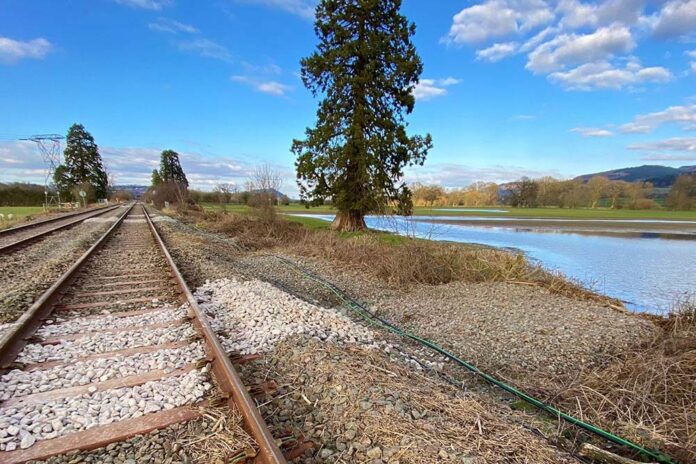Network Rail has announced it is carrying out millions of pounds worth of works in Wales to help protect the railway from extreme flooding and passenger disruption.
The announcement was made as Network Rail confirmed the Cambrian Line will reopen by the first week of April, after a trio of storms forced it to close in February.
Storms Dudley, Eunice and Franklin caused extensive damage across Wales. On the railway, a section of the Cambrian Line, near Welshpool, was hit by 33 track washouts over a half-mile stretch.
The flooding left gaping holes beneath the tracks, which Network Rail engineers have been working hard to repair, so trains can safely run again.
Network Rail has announced an additional £2m emergency funding to protect this section of the railway from extreme weather events in the future. Over the next few weeks, as well as repairing damage from the washouts, engineers will install more than 5,000 tonnes of rock armour on the embankment, alongside the railway.
Before the rock armour can be installed, more than 10,000 tonnes of materials will need to be transported to site to build a temporary 700-metre-long access road.
Rock armour has been successfully deployed to combat flooding in other areas including the Conwy Valley Line and the Marches Line, near Abergavenny. When the railway floods, the rock armour acts as a barrier to stop the ballast (stones that hold the sleepers in place) from being washed away by reducing the speed of the water and restricting its flow. Protecting the railway in this way allows lines to be reopened far more quickly after major flooding events.
To reduce the impact on passengers, the resilience work has been fast-tracked to take place alongside the storm repairs, while the railway is already closed. Other work being carried out over the next few weeks includes refurbishing culverts (the drainage beneath the tracks), renewing the tracks and planting additional hedgerows where there are gaps along the railway – which help protect the tracks from flooding and provides a perfect habitat for nesting birds and small mammals.
Buses continue to replace trains from Shrewsbury to Newtown. Train services will begin at Newton for those travelling further west. You can check your journey at https://www.journeycheck.com/tfwrail/.
Bill Kelly, Wales & Borders route director at Network Rail said: “Climate change is happening here and now so building a more resilient railway for Wales & Borders is a top priority.
“We know the Cambrian Line is a social and economic lifeline for the communities it serves. Building on our work to raise black bridge near Machynlleth and our £30m investment at Barmouth Viaduct – we’re committed to protecting the future of this vital transport link.
“I’d like to thank passengers and the local community for their patience. Our teams are working day and night to get this work completed as quickly and safely as possible.”
Jan Chaudhry-Van der Velde, managing director of Transport for Wales, said: “We welcome Network Rail’s announcement of an additional £2m of funding to enhance protection for the Cambrian Line.
“We understand disruption caused by storm damage, although beyond our control, is incredibly frustrating for our customers so we are grateful to Network Rail for completing this repair work as quickly as possible and for carrying out further work to protect the line in the future.
“Once again we would like to thank our customers for their understanding while this work is taking place.”
Ann Elias, strategic transport manager at Growing Mid Wales Partnership said: “Following the extensive flooding in the Severn Valley over recent weeks, which resulted in the closure of the Cambrian Line, I welcome the news that, not only are the works being under taken to re-open the line but, there will also be a significant package of resilience works – because the long term resilience of this strategic transport corridor is vital for our communities.”



































 0113 2082620
0113 2082620 info@railbusinessdaily.com
info@railbusinessdaily.com 15 Mariner Court, Wakefield WF4 3FL
15 Mariner Court, Wakefield WF4 3FL

